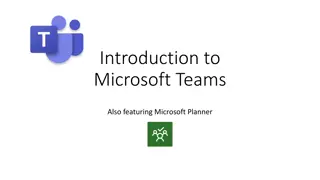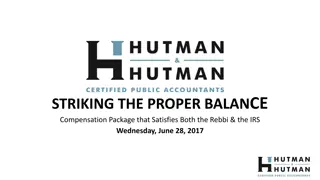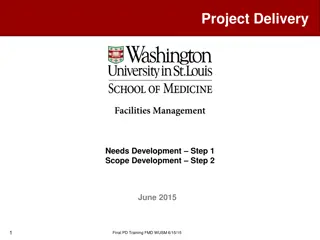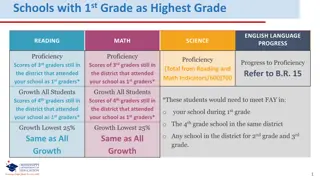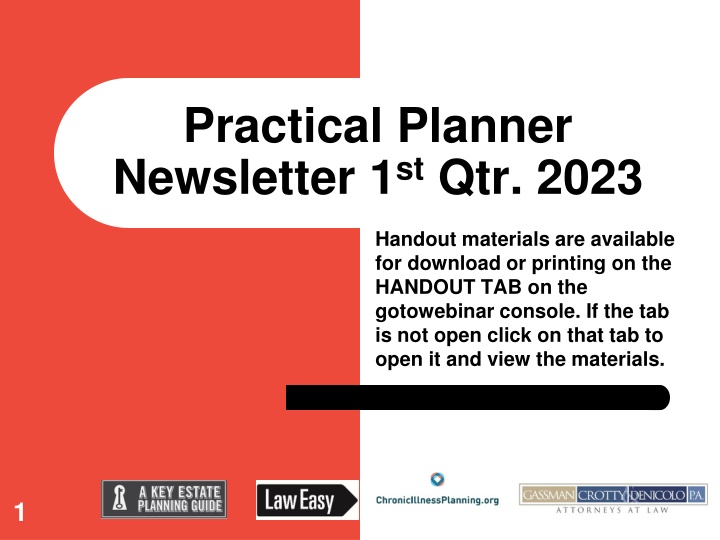
Corporate Transparency Act and Its Implications
Explore the Corporate Transparency Act (CTA), its stringent reporting requirements for privately held entities, and the potential impact on estate planning and asset protection. Learn about the significant penalties for non-compliance and the challenges associated with disclosing private information to the government.
Download Presentation

Please find below an Image/Link to download the presentation.
The content on the website is provided AS IS for your information and personal use only. It may not be sold, licensed, or shared on other websites without obtaining consent from the author. If you encounter any issues during the download, it is possible that the publisher has removed the file from their server.
You are allowed to download the files provided on this website for personal or commercial use, subject to the condition that they are used lawfully. All files are the property of their respective owners.
The content on the website is provided AS IS for your information and personal use only. It may not be sold, licensed, or shared on other websites without obtaining consent from the author.
E N D
Presentation Transcript
Practical Planner Newsletter 1stQtr. 2023 Handout materials are available for download or printing on the HANDOUT TAB on the gotowebinar console. If the tab is not open click on that tab to open it and view the materials. 1
Practical Planner Newsletter 1st Qtr. 2023 By: Martin M. Shenkman, Esq. and Alan S. Gassman, Esq. 2
Some Webinar Pointers All programs hosted by Shenkman Law are free and we focus on providing colleagues with practical and actionable planning ideas. Our goal is to help you, our colleagues, with your practice. The PowerPoint is available for download from the web console during the program. A recording of this program and the materials will be posted to www.shenkmanlaw.com/webinars. There is a growing library of 150+ webinar recordings there. There is a growing library of 200+ video planning clips on www.laweasy.com. There is no CLE or CPE for this program, but you will be sent a certificate of attendance from the webinar system. We cannot control those certificates so if there is an issue we cannot assist. If you have questions, please email the panel. All emails are listed on near the end of the slide deck. 3
General Disclaimer The information and/or the materials provided as part of this program are intended and provided solely for informational and educational purposes. None of the information and/or materials provided as part of this power point or ancillary materials are intended to be, nor should they be construed to be the basis of any investment, legal, tax or other professional advice. Under no circumstances should the audio, power point or other materials be considered to be, or used as independent legal, tax, investment or other professional advice. The discussions are general in nature and not person specific. Laws vary by state and are subject to constant change. Economic developments could dramatically alter the illustrations or recommendations offered in the program or materials. 4
The Corporate Transparency Act is Coming to Get You! New Reporting; Stiff Penalties 5
CTA Overview The Corporate Transparency Act (CTA) will require privately held entities to report detailed private information to the Treasury. The rules are complex, very different than anything that has previously been required, and provide for stringent penalties for non-compliance. The CTA will have a significant and disturbing impact by mandating new and invasive reporting about entities and their beneficial owners to the government. It is all encompassing, and it will affect many people who have undertaken estate planning, asset protection planning, own real estate, and more. Complying with the new CTA rules will be costly, nettlesome, concerning in terms of penalties, and will make you very uncomfortable disclosing information that you probably never did before. 6
What the CTA Does The CTAs goal is to create a comprehensive, searchable, national database of entities. The objective is to pierce entity solution and identify those behind each entity. You may have to disclose your name and home address, not office address or P.O. Box, to comply. This is worrisome. For those who are concerned about personal security, kidnapping and other activities, this is another step obviating privacy and confidentiality. More details on the disclosures appear below. This is part of a growing worldwide effort to combat criminal activities including tax evasion, money-laundering, and other financial crimes. This reporting has grown common in other developed countries but is new to the U.S. and represents an effort to get the U.S. on par to reporting standards in other countries. CTA reporting has requirements that are very different from tax returns and your CPA may not be able to, or perhaps may not be willing to, handle the CTA filings for you (you might need to engage your attorney). 7
You Will Likely Be Ensnared by the CTA CTA reporting will affect the owners or principles involved in almost all business entities. This includes limited liability companies (LLCs), corporations, limited partnerships (LPs and FLPs), and other closely held entities. When you engage in estate or asset protection planning, or structure business or real estate investments, you routinely have and will create entities that will be subject to CTA reporting. Investment planning might include forming a holding company LLC to aggregate securities or other investments. Businesses and a rental real estate properties are typically segregated into separate entities to avoid a domino effect if there is a lawsuit emanating from the underlying asset. Your estate plan might include the creation of one or more LLCs designed to hold other assets or even other entities to facilitate trust funding or trust administration. For example, it might be easier and less costly to transfer a basket of assets into an LLC then transfer slices of that LLC s ownership interests to various family trusts then to transfer the underlying assets. 8
You Will Likely Be Ensnared by the CTA LLCs are often formed to hold vacation homes or tangible property (e.g., art) that is physically located in a state other than your primary state (domicile) to avoid probate in those other states. A family limited partnership might have been created for management and estate tax valuation discount purposes, and other reasons. If you are engaged in planning to reduce the risk of a malpractice claimant or other claimant or predator reaching your wealth (asset protection planning) multiple entities might be created to insulate each underlying assets from claims of creditors. For example, you might transfer assets into a multi-member (more than one owner) LLC in order to take advantage of charging order protection which could limit a claimant's ability to reach the underlying assets. 9
Reporting Rules Few Exceptions from CTA Filing Requirements: Large active enterprises with 20+ employees and more than $5 million in revenues, or entities such as banks that are already subject to significant federal reporting requirements. So, unless your advisers confirm otherwise, you should start with the assumption that every entity involved in your planning must report. What Reporting Entities Will Have to Report: Reports will require the legal name and any trade names of the entity, a street address for company s principal place of business, state of formation, the Tax Identification Number (note that for a disregarded single member LLC you might be using your Social Security Number for the entity). Every Beneficial Owner Must Report: These are the people behind or controlling each reporting entity. You ll have to disclose your full legal name, date of birth, home address (a PO Box won t suffice) and you ll have to provide a PDF of your U.S. passport or state driver s license. This is sensitive, confidential and personal information that goes well beyond anything you had to report on an income tax return in the past. 10
More Reporting Rules Changes in Reported Information: Reporting entities must also report changes to any filing within 30 days. Example: One of the managers of an LLC you are involved with moves to a new home. That change of address will have to be reported within 30 days! That won t be easy and how will you know? If someone with an ownership interest in, or who has control over an entity changes their name, that will have to be reported in 30 days. You may have to assure that all of those people know to inform you of such changes so that you can assure that the required filings are made. Corporate counsel might have you amend governing documents (e.g., operating agreements for LLCs) to mandate that every signer complies with their reporting obligations and inform a designated person on behalf of the entity to report. The Financial Crimes Enforcement Network: FinCEN will be in charge of creating and maintaining the database of all info the government collects. It will be accessible to a variety of governmental agencies. 11
Who Is A Beneficial Owner to Report? The CTA will affect most small family businesses, including LLCs and other entities designed only to hold a vacation or rental home. Even if an entity has only one owner and is ignored for federal income tax purposes (like a single-member disregarded LLC), it may still have to file reports with FinCEN. I f you have any ownership interests in any closely held entity, such as an LLC, corporation, or limited partnership (any entity that required a filing with a state agency such as the Secretary of State or any similar office), then you may be subject to these requirements. The rules are broad and nuanced. Ownership is not limited to obvious ownership (e.g., you own membership interests in an LLC). It is broadly defined to include any type of equity interests (e.g., a profits interests, convertible instruments, warrants, options, puts, calls, and other entity interests). Ownership can be interests owned or controlled through joint ownership, through a trust agreement, or other indirect arrangements. All of these disparate rights may be subject to CTA reporting rules. 12
Even Non-Owners of Entity May Have to Report If you are not an owner of an entity, but you exercise the authority which a senior officer of the entity might hold, you also have to report. If you are not an owner or officer but if you have direct or indirect substantial control over the entity you may have to report. This might include a chief financial officer, general counsel, trust protector, trustee, etc. Remember the goal of the CTA is to reach those controlling the entity. 13
CTA Effective Date; What to do Now The CTA rules apply January 1, 2024. For entities that already exist by that date, their initial reports are due by January 1, 2025. For entities created on or after that date, an initial report is due within 30 days from the date of the creation of the entity. You and your advisers should begin the process now of identifying reporting entities and beneficial owners and gathering information to prepare for the eventual reporting requirements. Try to avoid the likely pressure as the deadline approaches and every attorney and CPA will be scrambling to help those who have not prepared. Compile a list of every entity you are an owner of, or involved with, and have your attorney review the reporting implications for that list of entities. You should not assume that any of your advisers, including the attorney that may have helped form an entity, has the information. They won t. This will take a proactive effort on your part. Maintain records of every entity you determine you do, or do not have to report for, and why, for future use. 14
Life Insurance Trusts (ILITs) Common But Not Simple 15
Insurance Trust and Insurance Irrevocable Life Insurance Trusts (ILITs) are one of the most common estate planning tools, but too often folks just don t give them the care and attention they require. No trust, estate plan or asset protection technique will work if you don t administer it properly and regularly with a collaborative team. There can be a significant number of documents, steps, and nuances (lots of variation between ILITs). These are not standard and be careful making assumptions. Consider the following. Insurance policies are the heart of ILITs but too often people make the dangerous assumption that if the policy made sense when the trust first purchased it that it makes sense decades later. Insurance is not a buy it and forget it decision. Have your policy and your circumstances reviewed every few years to see if the policy is working as desired and to be sure it meets current needs. Sometimes policies are great, sometimes they need to be added on to (i.e., more coverage). Sometimes they can be sold or cancelled. 16
When Did You Last Review the Trust? Most insurance trusts are irrevocable but that doesn t mean that they might not be changed. Review the trust instrument periodically or if there are major personal changes. Trustees can resign and new ones may be appointed. Old trusts often have inefficient or inadvisable administrative provisions. Those might be modified be decanting or merging the old ILIT into a newer trust. A common issue is old trusts paid all money out to beneficiaries at some age, e.g. 30, and that is rarely ideal. Review the trust and discuss with your advisers changes that might be desirable and whether they can be achieved. 17
Get Insurance and Trust Records You (the settlor who created the trust), the trustee, and your advisers should all have a complete and current compilation of all information and documents so each can fulfil their role and the ILIT can be properly administered. Includes: Memorandum explaining the plan as initially formulated and any follow up adviser communications. Insurance projections when the policy was issued and every few years when the policy is reviewed and evaluated. The initial insurance application should list the trust as owner (or if the policy was later transferred to the trust that documentation). A PDF of the insurance policies and an indication where the originals are. Fully PDF signed trust document and an indication where the original is. Over the years there may be trustee changes, actions by various persons holding powers under the trust (e.g., a trust protector), etc. PDF copies of all those documents should be held in chronological order so that the current status of the trust can be proven. 18
Gifts and Gift Tax Returns Gifts: When you make a gift to the trust most trusts require that the trustee give written notice to the beneficiaries to qualify the gifts for the annual gift tax exclusion. These are called Crummey notices. Review exactly what your trust says about these as there are lots of different nuances. Some advisers suggest beneficiaries waive the requirement of notice. Too many people just ignore the requirements. But keep in mind the trustee should adhere to the terms of the trust even apart from gift tax considerations. If there is a lawsuit creditors might not be required to respect the trust if you didn t. Save PDF copies of every year s notices.If the premiums are significant there may be documentation on a split-dollar loan or other financial arrangement to fund the trust (e.g., a tier of GRATs the back end of which may pass to the ILIT). Gift Tax Returns: If you made taxable gifts to fund the ILIT a gift tax return might be required. If you made only annual gifts with Crummey powers you might (discuss with your tax adviser) report those on a gift tax return to run the statute of limitations on audit. Similarly, if gifts were made between spouses before funding the trust (e.g., from one spouse to the other if the couple only has a joint checking account) some tax advisers recommend those be disclosed on the return. 19
More ILIT Steps TIN:ILITs probably should have their own Tax Identification Number although some advisers suggest using the settlor s Social Security Number since ILITs are almost if not always grantor trusts. Investments: Most ILITs never need an investment plan or tax return because they have nominal bank balances and an insurance policy. But many ILITs have investment assets as a result of the plan to prefund the trust, etc. So be sure that if you have investments apart from the policy those are being properly managed, and all steps related to that investment asset addressed. Bank: LITs should have their own bank account and personal and trust funds should never be commingled. Plan: Every few years review your ILIT plan. Might it be beneficial to change insurance coverage, remove and replace a trustee, move the trust to a better state, decant or merge the trust into a newer trust, etc.? Over years, and certainly over decades, much can change and your ILIT plan should, to the extent feasible, evolve with those changes. 20
Revenue Ruling 2023-02 No More Basis Step Up? 21
Revenue Ruling 2023-02 This Ruling states the IRS position that the basis adjustment under Code Sec. 1014 does not apply to the assets in an irrevocable grantor trust not included in the deceased grantor s gross estate for Federal estate tax purposes. The basis of those assets is not stepped up to fair value on death even though the grantor trust s owner is liable for Federal income tax on the trust s income, the assets of the grantor trust are not considered as acquired or passed from a decedent by bequest, devise, inheritance, or otherwise within the meaning of Code Sec. 1014(b), and therefore 1014(a) does not apply. IRB: 2023-16, dated April 17, 2023. 22
Kalikow Case No Deduction; Lessons on Family Dysfunction 23
Kalikow Tax Message A recent Tax Court ruling reaffirms estate inclusion rules governing qualified terminable interest property (QTIP) trusts and the requirements for valuation of QTIP assets and determination of expenses. It also presents yet another lesson in how estate plans and family challenges can pose difficulties for all. Estate of Kalikow v. Commissioner, T.C. Memo. 2023-21. The court considered the issue of deducting administrative fees from an estate to reduce estate tax due, and discussed Code Sec. 2053. Husband s will created a QTIP for wife that included a requirement to pay the surviving wife all income. Most of the assets in the trusts were interests in an FLP that owned rental real estate. Wife was entitled to income distributions from the trust for life, and on her death, the assets remaining in the QTIP were to be divided and paid to trusts for each of the two children. It was asserted that wife had underpaid income of almost $17 million. Litigation followed, and a settlement was reached in which the QTIP agreed to pay the wife s estate about $6.5 million of undistributed income and about $2.7 million in fees. The estate was held not entitled to deduct any part of the agreed-on settlement payment as administration expenses pursuant to Section 2053. 24
Kalikow Planning Message The family, estate and trust endured 10-years of litigation. The tax issues the family lost might pale in comparison to the legal costs incurred and the personal damage to the family. 25
Biden Administration Greenbook Scary but Can Any of it Happen? 26
Biden Administration Greenbook The Biden administration issued its budget proposal, the so-called Greenbook. For a detailed analysis and planning implications see the paper posted to the blog post on www.shenkmanlaw.com. With a Republican controlled House can any of this be enacted? Many assume never but never is a risky word with Washington politics and with the uncertainty over the debt ceiling might be resolved, anything is possible. Many of the provisions are similar to the harsh proposals made in prior years by Senator Sanders. Some have been modified and new ones added, but you get the drift. 27
Agent Confusion and Inconsistencies Possibly a Big Problem and it May Affect You! 28
Agent Confusion and/or Inconsistencies You probably have a many disparate fiduciary and quasi-fiduciary appointments, and they are probably not planned or consistent. Determine all such appointments and coordinate them with the fiduciaries named under your legal documents so that they do not undermine the safeguards you created. You may not even realize who is named in some old appointments and they may be people you can no longer rely on. Some of the many appointments might include: Authorized signer on safe deposit box. Trusted contact your brokers listed under FINRA Rule 45 12, Customer Account Information.. Social Security s Administration (SSA) Representative Payment Program naming someone to receive your payments. Long term care insurance lapse designee to get notice of a lapse of your policy. Successor Account Holders on 529 plans. Bank accounts POD, TOD, joint, etc. These may have been created long ago and never updated to reflect your current estate plan. Funeral agent. Physician Order for Life sustaining Treatment (POLST) signed with the client s physician. Financial positions perhaps should be coordinated with your financial power of attorney. Personal positions perhaps should be coordinated with your health care proxy. # 29
Community Property Caution is in Order 30
Consider Community Property Issues Before implementing estate or asset protection planning, evaluate whether any of your assets may be community property. The fact that you have lived in a non-community property state for decades won t alone change the character of property you acquired while living married in a community property state (e.g., TX, AZ, etc.). Say you and your spouse own entity interests as community property and you want to contribute 1/2 those interests to a trust for your spouse (a SLAT). You must have counsel in the state where the community interest was created transmute or terminate the community interest. That might result in of the value of the investment being owned by each of you. If Wife wants to transfer all those interests to a trust for Husband and decedents, Husband first must make a gift to Wife of his 1/2 post-transmuted interests.) 31
Consider Community Property Issues Time should pass before Wife gifts those interests to a trust for Husband, and other steps taken to deflect a step-transaction issue. Some might view the quick transfer of transmuted community property as the transfer of an asset the donee spouse had a community interest in. Wife should consider the economic impact on her if there is a future divorce. Wife had interests in the community property now it may reside in Husband (if no gift) and the rest in a trust for the Husband, and nothing for her. 32
Conclusion and Additional Information Lots of New Ideas and Issues to Consider 33
Conclusion The Corporate Transparency Act is big stuff and all advisers need to gear up. ILITs are ubiquitous in planning but that doesn t suggest most are handled well. Some new cases bring new rules and reminders of old lessons. Agents and all client appointments need to be considered. Community property presents lots of traps. 34
Additional information Alan S. Gassman agassman@gassmanpa.com Martin M. Shenkman shenkman@shenkmanlaw.com 35



